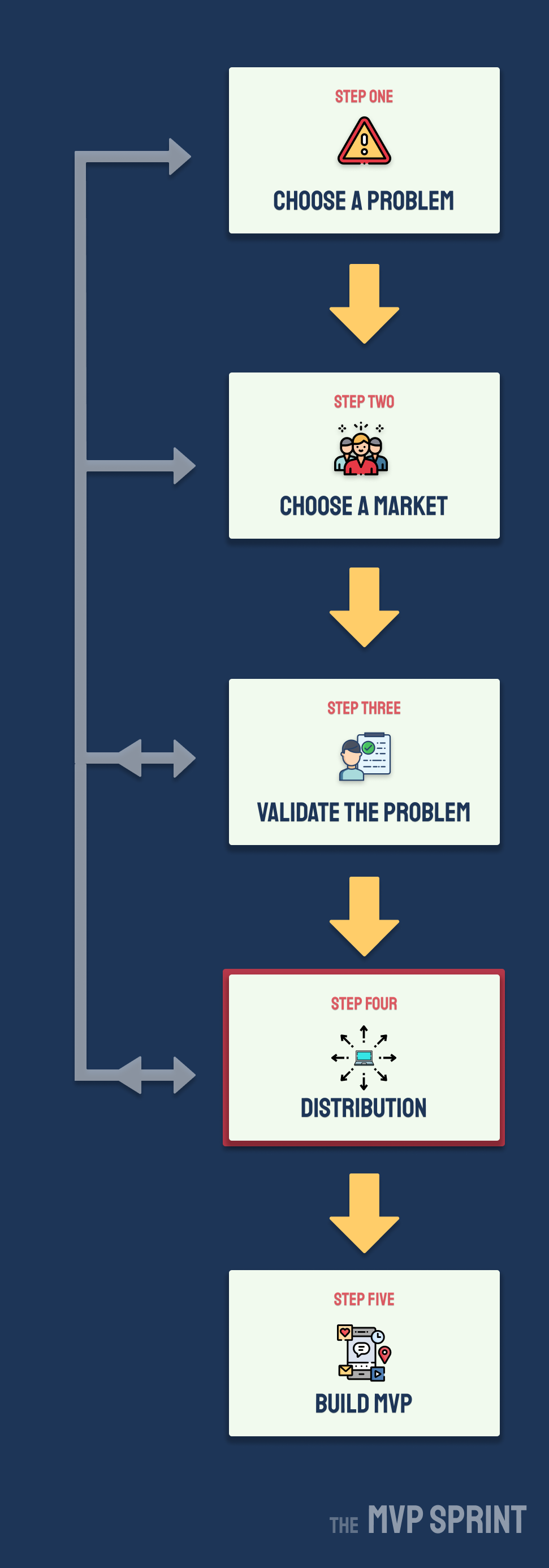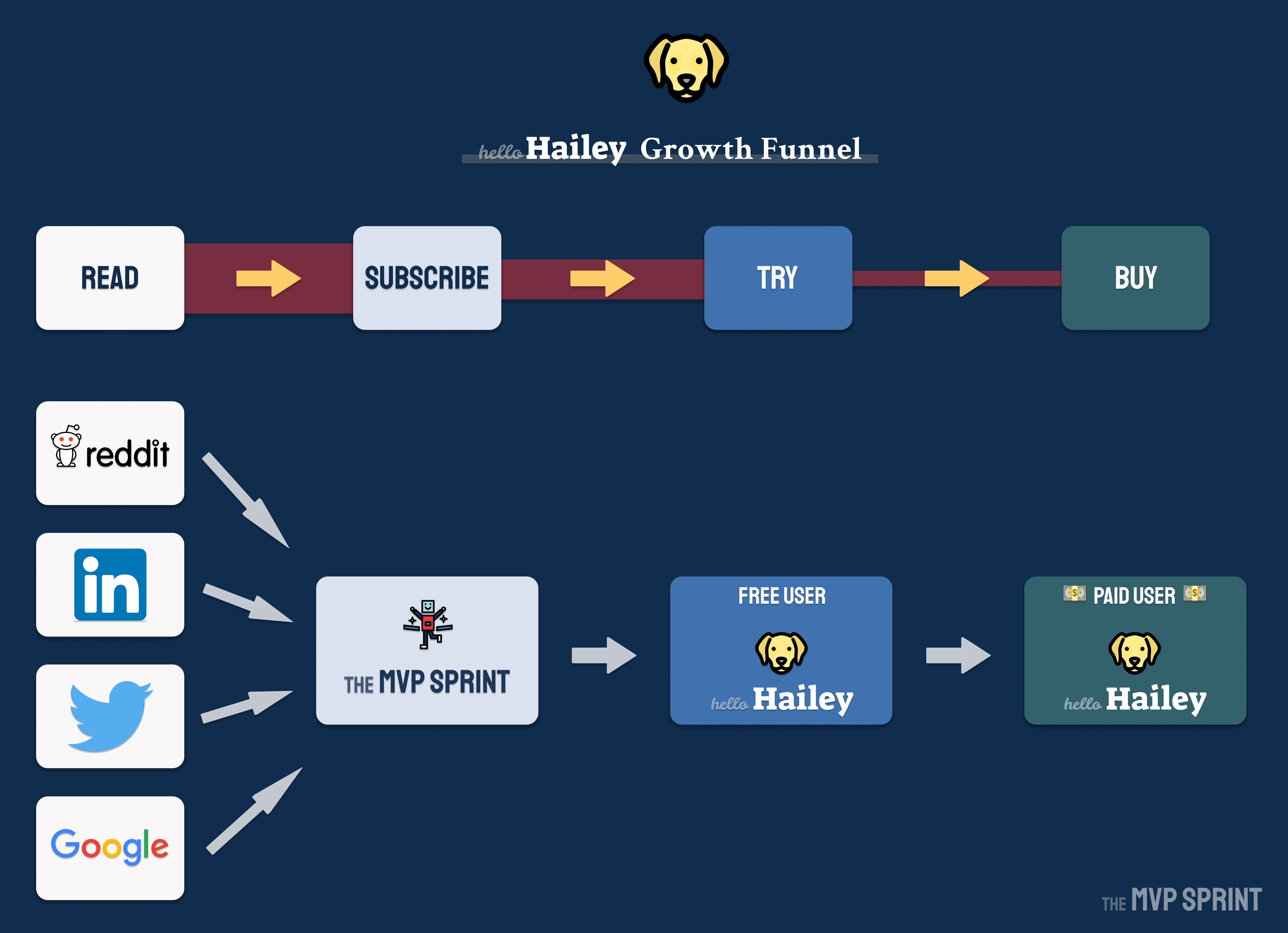My side projects always fail. This one is different.
Building stuff has always been the fun part for me.
It’s why my side projects generally follow this pattern:
- Have an idea
- Build something
- Try (unsuccessfully) to get users
- Give up and move on
How I’ll acquire users was always an afterthought - something I did after there was a product for them to use.
This time, I’m trying something new.
If a product ships in the woods, and no users are around to hear it, does it make money? 🤔
💸 From idea to revenue
This is part 4 of my MVP Sprint - my step-by-step process to go from idea to MVP and paying users. Originally inspired by Google's Design Sprint.

Distribution is just as important as product.
-
Hotmail went from 0 to 12 million users by appending a message to outgoing emails.
-
Eventbrite's events drove user growth.
-
Dropbox achieved 34x growth in 2 years via their referral program.
I'm building HelloHailey for product and engineering managers in tech.
I need to find places where these users are already giving their time and attention.
I need channels that are free with low barriers to entry
- Free - I don’t plan on paying to acquire users for a long time. “Cheap” isn’t good enough.
- Low barriers to entry - Eventually I'll need long-term barriers, but I need users now.
Growth Hypothesis #1:
Product managers will engage with meta content about HelloHailey metrics and strategy.
I'll be sharing everything in public:
- All my metrics
- Product strategy
- Experiments and results
- Successes and failures
PM's will discover this content on Twitter, Linkedin, Reddit, and Google (SEO) via The MVP Sprint.
Some readers will give their email address and subscribe.
Some subscribers will try out HelloHailey with their teams.

Growth Hypothesis #2
HelloHailey will expand within a company through product-led growth.
A user's experience is better when more of their coworkers are using it. Intra-company network effects will drive intra-company user growth.
I don't know if this will work.
But either way, I'll be hanging my dirty laundry out for all to see.

Rule of thumb 1: arrows are often the biggest assumptions.
Rule of the other thumb: users won't flow like expected or when expected and you'll often need a very good plumber.
Haha, love these thumb rules.
Agreed :)
I still think there's value in having a north star to aim towards, even if the path there is a windy one.
I agree, goals are still very important, and we have to strive to achieve as many as we can.
Hey Tim. I am a PM at a tech company. Checked out your website.
I have no idea what your product does.
asynchronous water cooler to me = Slack.
What problem does your product solve?
Yea I agree the landing page is pretty unclear. I haven't spec'ed the product myself yet :)
I put up the landing page in 24 hours on Webflow to be able to catch the few people for whom that problem really resonated.
Outside of this post, I've only linked to it within my weekly newsletter where there's a lot more context.
This is the problem I'm solving:
As a remote product or engineering leader in tech, it's hard for my team to develop personal connections with teammates distributed across time zones.
While this may be a problem, is it one that needs solving? I've worked at places which have "teammates distributed across time zones" and forming a personal connection is not a problem with existing tools like Slack or Zoom - assuming we want to develop personal (as opposed to professional) connections. Moreover as a remote worker being connected 24/7 is not always desirable - I need time alone to focus on tasks and not get pinged every five minutes. Most companies already have a "water cooler" Slack channel for teams who want them.
The problem definition I think fails on two counts: it's too vague and it's already adequately addressed by existing tools. Defining the problem before coding is all well and good, but it doesn't help if the problem is not well-defined to begin with.
If I were to look for a problem I can see with companies I know, that they might actually pay good money for, I'd start with the problems that are badly served by existing tools - for example, HR manages the quarterly performance reviews by cut-and-paste from lots of Google docs sent to them by managers. Lots of manual work for everyone involved and very hard to parse out useful information that can go into a report or chart. Would it be possible to build a SAAS tool for this? Are there existing tools that do this? If so, why do people not use them?
I'm sure this is true for you - for lots of teams this isn't a problem at all.
In this article, I went through a pretty thorough validation process. The top things I was looking to understand were:
It turns out PM's and EM's are spending a lot of time today to attempt to solve the problem, and companies are spending money on solutions.
You might want to try getting some interviewees for your user research at https://www.userinterviewexchange.com/
There’s a bunch of product managers on the platform.
I think it's a valid problem.
If you want to make it more relevant for a magnitude more teams, in COVID times that problem touches even teams in same timezone that are just remotely located. It's easy to lose that connection when you're trying to bond over a clunky zoom everyone can't wait to get off of.
Yea I agree!
Interesting post, Tim.
Have you considered how you will be collecting and storing all of the feedback that comes your way? I think that you could be an interesting case for my product Noora (https://noorahq.com). We've got a pretty awesome Chrome extension that will let you capture all of the qualitative data that your users send you through emails etc and build your product-led growth roadmap from this data.
I'm going to just say you have a huge contradiction on how you went about your product:
You are "building HelloHailey for product and engineering managers in tech" so basically you are choosing to make a B2B tool.
But you want "channels that are free with low barriers to entry" which are not really compatible with B2B products.
I don't think you'll manage to get more than a few hobbists to use it.
And it's not really clear what you offer. A virtual dog? How does that work? What's the point? What's in for me as a customer? I am a tech engineering manager ish (CTO) but I have no idea what you offer and how it would make my team more productive or better off.
We'll see! So far I have ~300 email subscribers and ~50 people on the waitlist, plus a bunch of EM and PM friends that are going to try it with their teams.
Obviously far from a sure thing that they will love and use the product (or even try it), but I have reasons to be optimistic about the strategy so far.
The specific solution is purposely vague - I focused on the problem and product outcomes with the landing page, hoping that people that experienced that problem and wanted those outcomes would sign up.
I haven't even defined my product yet, but the landing page took me 24 hours and allows me to collect and pre-qualify leads before I build one.
Focus on validating the problem first. Which specific problem are you going to solve? For who? The more specific you get with this, the easier it will be to market your product/service.
I outlined the process of finding a problem to solve in my first post. Then I niched down further within that problem in my second post.
My problem is: As a remote product or engineering leader in tech, it's hard for my team to develop personal connections with teammates distributed across time zones.
good stuff have you ever read the startup owner's manual? Have you just tried to get feedback for a repeatable business before scaling?
I haven't! But I've taken some inspiration from The Lean Startup.
Feedback can be helpful but I think you should try for a bit more validation. The Mom Test is my go-to resource for how to collect feedback.
Will at to my list of reading
Hi Tim,
We cannot be all things... find a business partner who has a sales background and who can bring advice and experience to take your product to market.